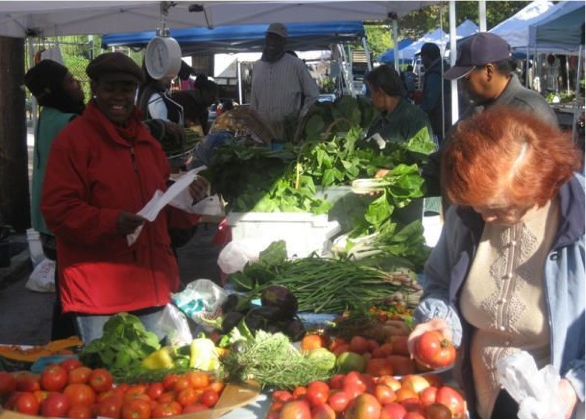 The term “food desert” usually is associated with low income, urban areas where access to food is limited, meaning no supermarkets within a ten mile radius. Many believe that the implementation of grocery stores in those areas is the most important step towards flowering the deserts and, as a result, gaining ground on the obesity epidemic sweeping America. But new research suggests that better access to grocery stores doesn’t improve people’s diet.
The term “food desert” usually is associated with low income, urban areas where access to food is limited, meaning no supermarkets within a ten mile radius. Many believe that the implementation of grocery stores in those areas is the most important step towards flowering the deserts and, as a result, gaining ground on the obesity epidemic sweeping America. But new research suggests that better access to grocery stores doesn’t improve people’s diet.
According to the LA Times, the study, which tracked thousands of people in several large cities for 15 years, found that people didn’t eat more fruits and vegetables when they had supermarkets available in their neighborhoods.
Instead, income–and proximity to fast food restaurants–were the strongest factors in food choice.
These finding are sure to make people feel like there is now no hope for the nation’s poor in their fight against obesity, How are they going to realistically lift themselves out of the traps of cheap, industrialized food pushers?
On the contrary, this study seems to prove that their will not be a corporate answer to food-related issues and diseases like diabetes, high blood pressure, and/or cancer.
The results, published Monday in The Archives of Internal Medicine, demonstrate that the pleas from activist in poor neighborhoods are more desperate than ever. They seem willing to accept any answer even if that solution actually floods the neighborhoods with more subsidized corn, soy, wheat, and factory-farmed meat.
The study looked at more than 5,000 African American and Caucasian men and women Birmingham, Ala., Chicago, Minneapolis, and Oakland between 1985 and 2001. The researchers assessed participants’ diets over the years and tracked how far they lived from supermarkets and fast-food restaurants. The study did not measure their weight or body mass index.
Living near fast-food restaurants was the best indicator of poor diet, as the cheap food allowed people to feed their families on a budget. Remarkably, easy access to supermarkets didn’t translate into people buying fresh produce, leaner meats, and/or low-fat processed foods like yogurt or whole grain bread.
In a story by Shane Roberts on Clutch Magazine, he asked:
How are we to convince young African-Americans to care about the environment when their lives, in a city, are completely dependent upon corporate entities to provide for their basic needs.
That question has now been answered by this report. No longer are large corporate takeovers, in the form of Whole Foods and Trader Joe’s, of urban areas the answer to issues related to food and diet. Education, a living wage, and small community farms and co-ops are clearly the first steps towards fighting the obesity epidemic.
Stories about the moratorium on fast-food restaurants in South L.A. makes sense now even though the bill’s lead sponsor, Jan Perry, solution was more super markets in the most black and Hispanic area.
J. Justin Wilson, senior research analyst for the Center for Consumer Freedom, a Washington, D.C-based organization funded by the restaurant industry, said that such measures have an “anti-corporate whiff” and that this study shows that government meddling is not the answer.
“Trying to change the market doesn’t necessarily work and at the same time undermines personal responsibility,” he said.
But the market is proving over and over that it’s not giving people a fair choice. One cannot expect to a person, who is cash-strapped, to choose a head of fresh, non-GMO vegetable for $4 when you can buy two boxes of cereal for the same price, feeding a family for over a week opposed to a nights worth of vegetables.
It’s a tough situation, but there is no doubt larger discussion must be had before this nation becomes any more unhealthier.







Very interesting read! While most residents and activists look at conditions such as public safety, housing availability, public education, environmental concerns and economic opportunities when taking on community development issues, seldom do we consider one of the most basic elements – how an area feeds itself – as a sign of neighborhood well being.
I’m definitely going to share this article with friends and family. Its a topic that needs to be discussed.
Thanks for posting!
“One cannot expect to a person, who is cash-strapped, to choose a head of fresh, non-GMO vegetable for $4 when you can buy two boxes of cereal for the same price, feeding a family for over a week opposed to a nights worth of vegetables.” I don’t think this is the best comparison to make. Cereal vs. vegetables?
Well, perhaps those veggies could be cut up and frozen for the week. Many veggies are stable with proper refrigeration. There are ways. I live in nyc and i suppose we are blessed. No everyone does not live near a farmers market. However there are a few in every Borough. They do take “Food Stamps”. There are sometimes all of these public health students at a booth giving lessons on how to prepare some of the in season fare. (Sometimes they are patronizing but that is another topic) It wasn’t always this way, give it time to catch on. The initiatives should continue.
@minna k: It’s actually a great comparison because cereal is a staple of civilization that is marketed now as staple food for the optimal health. Frosted Flakes, Special K, or even Honey Nut Cheerios are not ideal breakfast foods. They’re only healthy in comparison to other bad food!!! like Pop Tarts, Sugar-laced oatmeal, and/or processed breakfast sandwiches.
There is no evidence that grains, whole or not, are health foods. NONE! I’m sorry. They are merely storable foods that help us figure out ways to do everything else in the world besides eat living foods